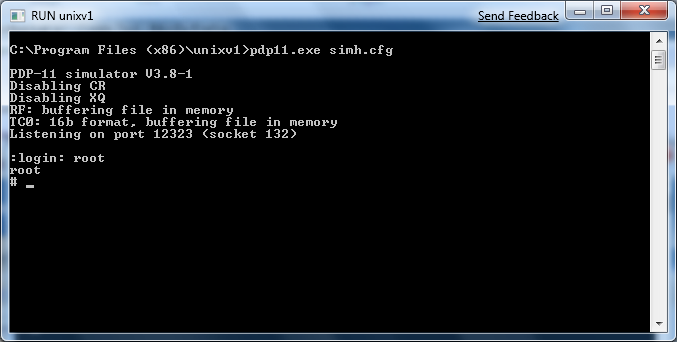Today I have decided that I should make a windows installer for the Unix v1 restoration project’s efforts on getting Unix v1 running.
For windows users this is a simple click & install project. This version of Unix v1 will support up to 8 simultaneous users on the system. Please note that this is a ‘rework’ of the v1 kernel from printouts to run a v2 userland, and the earliest C compiler from somewhere around v3-v4. It is not ‘pure’ per say as almost all v1 Unix documentation, tapes have been lost.
Simply install with all options, then click on the “RUN unixv1†link, and the kernel will load up (quickly!) to a login prompt. Login as root, and you should be good to go. Additional users can telnet into the host PC on port 12323 and they will be prompted to login. You can also use the “attach a pty†link, and it will launch teraterm pro onto the port 12323.
Because of the age of this system lots of commands that you take for granted did not exist back in 1972. A quick survey of my own use led to this:
Sync –doesn’t exist-
Reboot –doesn’t exist-
Vi –doesn’t exist-
Clear –doesn’t exist-
Cd –it’s actually chdir
Finger –doesn’t exist-
UUCP –doesn’t exist-
TCP/IP –doesn’t exist-
Remember it’s on a system with 32kb of ram. Don’t confuse Unix’s humble beginnings with the later v7 on the VAX, or the BSD releases that added TCP/IP networking.
I have included the PDF for the 2nd edition programmers guide. Since the userland is from this generation it is as close as you will get to a system manpage.
To exit the emulator, you can just close the SIMH process window, or hit Control+E then q to quit. I’m not sure of a ‘clean’ way to reset a Unix v1 machine. If there is significant disk corruption, I’d just recommend un-installing this program, then re-installing. It is no doubt the saving grace about running this emulated. As far as I know nobody has run this on a physical PDP-11. You would require an actual 11/20 because of how the multiply / divide instruction is handled. I won’t run on any of the bigger PDP-11’s.
The project page is:
http://sourceforge.net/projects/bsd42/
You can download this release from here:
https://sourceforge.net/project/downloading.php?group_id=204974&filename=Research-unixv1-0.3.exe&a=32102074

